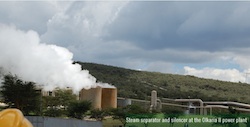In my latest book review, Energy, Convenient Solutions, author Howard Johnson predicts that geothermal energy will play the biggest role in our energy future. Maybe because I’m now paying more attention to geothermal energy, it seems that some pretty significant geothermal projects have been announced recently. For example, Kenya has unveiled its plans to build the largest geothermal power plant in Africa. The plant, once operational, would have the capacity to generate 2,000 megawatts (MW) per year.
 The $3.4 billion Borgia-Silali geothermal project is under development by the Geothermal Development Company (GDC) who plans on building out the project in four phases. GDC believes this project is critical in helping to resolve Kenya’s “critical recurring energy crisis.” The first phase of the project will involve the construction of a plant that will generate 800 MW by 2017. Phase II, with a capacity of 400 MW, is expected to be completed by 2019, while Phase III and Phase IV, each with a capacity of 400 MW, are expected to be completed by 2021 and 2023 respectively.
The $3.4 billion Borgia-Silali geothermal project is under development by the Geothermal Development Company (GDC) who plans on building out the project in four phases. GDC believes this project is critical in helping to resolve Kenya’s “critical recurring energy crisis.” The first phase of the project will involve the construction of a plant that will generate 800 MW by 2017. Phase II, with a capacity of 400 MW, is expected to be completed by 2019, while Phase III and Phase IV, each with a capacity of 400 MW, are expected to be completed by 2021 and 2023 respectively.
GDC is a state-owned company and is currently finalizing investors for this portion of the project and are already taking bids for Phase 1, that entails the construction of eight 100 MW power plants in the Bogoria-Silali area.
This is not the only area Kenya is targeting for geothermal power. GDC is also building a 400 MW geothermal plant in the Menengai caldera field and the geothermal power plant in Olkaria is generating 280 MW per year. The country’s current energy demand peaks today around 1,200 MW and is projected to grow by 10 percent to at least 17,000 MW over the next 20 years. The country hopes to generate at least 5,000 MW of energy by 2030 through geothermal power although GDC has identified 14 high potential sites along the Rift Valley that could generate between 7,000 – 10,000 MW.

